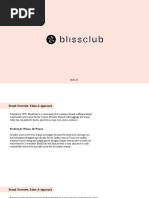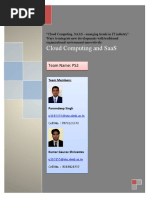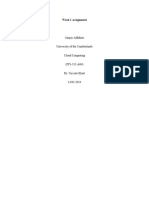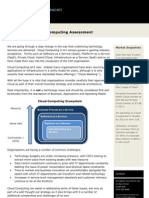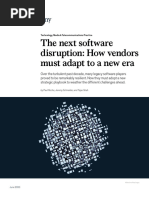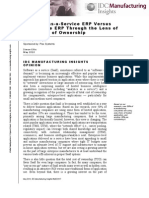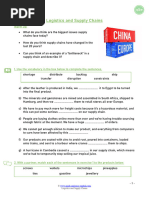THINKstrategies WP - ISVs Migrating To A SaaS Model - A Roadmap To Success
THINKstrategies WP - ISVs Migrating To A SaaS Model - A Roadmap To Success
Uploaded by
Andrey PritulyukCopyright:
Available Formats
THINKstrategies WP - ISVs Migrating To A SaaS Model - A Roadmap To Success
THINKstrategies WP - ISVs Migrating To A SaaS Model - A Roadmap To Success
Uploaded by
Andrey PritulyukOriginal Title
Copyright
Available Formats
Share this document
Did you find this document useful?
Is this content inappropriate?
Copyright:
Available Formats
THINKstrategies WP - ISVs Migrating To A SaaS Model - A Roadmap To Success
THINKstrategies WP - ISVs Migrating To A SaaS Model - A Roadmap To Success
Uploaded by
Andrey PritulyukCopyright:
Available Formats
A Whitepaper for
Independent Software
Vendors (ISVs)
Migrating to a SaaS Model:
A Roadmap to Success
An Independent analysis published on behalf of Verio.
Migrating to a SaaS Model:
White Paper A Roadmap to Success
Executive Overview
A confluence of market forces are driving organizations of all sizes to adopt a
new generation of web-based, on-demand, Software-as-a-Service (SaaS)
solutions to meet their changing business requirements.
These organizations are adopting SaaS solutions of all kinds, ranging from ‘front-
office’ applications, such as customer relationship management (CRM) systems;
to ‘back-office’ applications, such as accounting and financial systems; to
collaboration; IT management solutions; and industry-specific applications.
The rapid growth of SaaS is attracting a proliferation of new and established
independent software vendors (ISVs) seeking a share of the market. This ‘cloud
rush’ is putting greater pressure on aspiring SaaS providers to quickly develop
and deliver highly differentiated solutions at the lowest possible cost. And, it is
also forcing them to make important decisions about how to properly deliver their
services to ensure they are reliable, secure and high performing.
For most SaaS start-ups and established ISVs migrating to a SaaS model it
doesn’t make economic or business sense to build their own hosting facilities to
deliver and support their SaaS solutions.
Instead, smart SaaS vendors are teaming with proven hosting companies who
can provide a cost-effective and scalable service delivery infrastructure so the
SaaS vendor can focus on developing and marketing a differentiated solution.
The leading hosting companies provide a full lifecycle of enablement capabilities,
technical skills and strong ‘ecosystem’ of business partners to help aspiring SaaS
vendors succeed.
This whitepaper will examine today’s SaaS opportunities and challenges, and will
show how a hosting company, such as Verio, can help ISVs capitalize on the
rapidly evolving market opportunities.
© THINKstrategies, Inc., 2010 www.thinkstrategies.com p.2
Migrating to a SaaS Model:
White Paper A Roadmap to Success
The Market Forces Driving the Growth of SaaS
A convergence of four key macro-market trends is driving companies of all sizes
to adopt SaaS solutions to support their increasingly dispersed employees, better
serve their decreasingly loyal customers and better coordinate with their
widening array of corporate partners.
These market trends include,
Changing economic conditions
Changing competitive forces
Changing workplace requirements
Changing technology requirements
The current financial crisis has impacted businesses of all sizes, causing layoffs,
tightening budgets, and forcing decision-makers to re-evaluate their capital
investments and refocus their limited resources on their core competencies.
The competitive landscape is also being reshaped by globalization and
eCommerce which have opened new market opportunities, but also lowered the
barriers to entry in nearly every industry resulting in greater competition and
lower customer loyalty.
The workplace is also being redefined by more dispersed and tech-savvy
workers who are more mobile and adept at leveraging technology to perform
their day-to-day jobs. Broadband networks and mobile technology are enabling
employees to work anywhere. But, they also need greater access to information,
traditionally hidden behind the firewall, in order to perform their jobs.
These trends are forcing organizations of all sizes to re-think how they leverage
software and technology to better support their rapidly changing business
requirements to achieve their corporate objectives.
Traditional, legacy on-premise applications and systems were not designed to
respond to these challenges. Instead, they were architected with a highly
centralized organization in mind. They have also proven to be too expensive and
cumbersome to acquire, deploy and maintain to meet organizations’ changing
needs. As a consequence, many enterprise on-premise applications have failed
to produce the return on investment (ROI) that organizations expected and have
required a higher total cost of ownership (TCO) to keep them up and running.
Because most organizations cannot afford these inefficiencies in today’s tough
environment, a growing number of organizations are adopting a widening
assortment of SaaS solutions to address varying business needs.
‘On-demand’, SaaS solutions leverage the web to give users anytime, anywhere
access to business applications. These solutions can be deployed quickly without
the upfront capital investments and ongoing support costs associated with
traditional, on-premise software. As a result, SaaS solutions offer a quicker time
to value at a lower cost of ownership.
THINKstrategies has seen a steady increase in customer interest and adoption of
on-demand SaaS solutions. Our most recent survey of over 100 mid- and large-
scale enterprises worldwide conducted in October 2008, in conjunction with
© THINKstrategies, Inc., 2010 www.thinkstrategies.com p.3
Migrating to a SaaS Model:
White Paper A Roadmap to Success
Cutter Consortium, found 63% of the companies surveyed had adopted a SaaS
solution, nearly double the percentage in 2007! (See, Figure 1.)
Figure 1
Percent of Companies Using and Considering SaaS Solutions
Source: THINKstrategies/Cutter Consortium, 2008.
Our findings have been validated by a recent study by McKinsey & Co. and
Sandhill.com which found 74% of the CIOs they surveyed are either using or
willing to consider SaaS alternatives to meet their IT and business needs.1
Our survey also found over 90% of those already using a SaaS solution are
satisfied with the quality of the solution, plan to expand their use of SaaS and
would recommend a SaaS solution to their peers.
It is for these reasons that companies of all sizes are adopting SaaS and cloud
computing at an accelerating rate. As a result of these trends, IDC forecasts the
SaaS market will experience a 24.4% compound annual growth rate (CAGR) and
will exceed $15 billion in 2012.2 In comparison US IT spending growth will be low
single digit in 2010 and then advance at a compound annual growth rate (CAGR)
of 6% over the same forecast period, according to Business Monitor
International’s “United States Technology Report Q4.”
1
“Enterprise Software Customer Survey 2008”, McKinsey & Co. and Sandhill.com,
http://www.interop.com/downloads/mckinsey_interop_survey.pdf.
2
“Worldwide Software on Demand 2008-2012 Forecast and 2007 Vendor Shares: Moving Toward an On-
Demand World” (IDC #213197, July 2008).
© THINKstrategies, Inc., 2010 www.thinkstrategies.com p.4
Migrating to a SaaS Model:
White Paper A Roadmap to Success
‘Cloud Rush’ Poses New Challenges for ISVs
The growing demand for SaaS solutions is attracting an increasing number of
ISVs to the market, creating a ‘cloud rush’ effect which THINKstrategies believes
will inevitably result in a shake-out and consolidation in the SaaS industry.
A clear barometer of the proliferation of players entering the market is
THINKstrategies’ SaaS Showplace (www.saas-showplace.com) which now has
over 1200 providers listed across 80 application industries and enabling solution
areas. Even in the best of times, few markets can support this many vendors.
And, today’s credit crunch is making it especially difficult for a growing number of
start-ups as well as some established vendors to survive.
The aspiring SaaS providers who do survive an inevitable industry shake-out will
be those who develop clearly differentiated solutions and deliver them in a cost-
effective and reliable fashion.
These are not easy objectives because the SaaS model changes many of the
fundamental rules of the software game. First, it puts the burden of customer
success on the shoulders of the vendor, fundamentally changing the nature of
the customer/vendor relationship. In the past, the customer was responsible for
deploying and maintaining their business applications, and the ISV simply had to
respond to technical questions and periodically issue software updates and
upgrades.
In the SaaS model, the vendor is responsible for ensuring the availability,
reliability, security and scalability of the software solution. With the pay-as-you-go
subscription pricing model, if the vendor fails to meet the customer’s
expectations, it is at risk of losing the customer. In addition to the threat of also
hurting its reputation in the market, the SaaS vendor may also be liable to pay a
penalty for failing to fulfill its obligations under a service level agreement (SLA).
The pay-as-you-go subscription pricing model poses additional financial pressure
on the SaaS vendor. The subscription pricing model allows organizations to
incrementally adopt SaaS solutions and avoid the upfront capital investments
associated with perpetual software licenses. The SaaS subscription pricing
model also means ISVs receive less upfront capital to finance the development
and delivery of their SaaS solutions. This requires SaaS companies to change
their fundamental philosophy and approach to how they architect, support, and
deliver their software application. In the on-premise model, software companies
were able to build and maintain their own IT infrastructure and had the upfront
capital needed to fund those expenses. In the SaaS model, software companies
will need to reduce their IT infrastructure costs to remain competitive. As a result
many will leverage the performance and economies of scale made available
through hosting service providers, also referred to as Cloud or Virtual IT service
providers, to achieve the scalability and reliability they need at reduced costs.
In addition, most established ISVs are migrating from an on-premise, single-
instance, packaged software architecture to a multi-tenant architecture which
makes SaaS more scalable and profitable. Re-architecting these applications
takes specialized software development skills and service delivery capabilities. It
also requires sophisticated service provisioning, monitoring, metering, hosting
capabilities, and the ability to rapidly scale.
© THINKstrategies, Inc., 2010 www.thinkstrategies.com p.5
Migrating to a SaaS Model:
White Paper A Roadmap to Success
SaaS vendors must also demonstrate that they have sufficient security policies
and procedures in place to safeguard customers’ sensitive corporate data. These
policies and procedures must also be properly certified, a process which can cost
thousands of dollars and take months to attain SAS 70, PCI or other necessary
certifications.
Given the competitive landscape and economic climate, most ISVs cannot afford
to make these investments to simply put the right service delivery infrastructure
and proper certifications in place. Instead, they must focus their resources on
building the best SaaS solutions possible at the most competitive price to satisfy
escalating customer expectations and remain competitive.
It is for these reasons most aspiring SaaS providers are turning to proven hosting
companies to support their service delivery requirements.
These SaaS companies find that it is more advantageous for them to
leverage the technical IT expertise and economies of scale that a hosting
service provider can offer. Successful SaaS providers leverage the
strengths of an experienced hosting service provider which allows them to
remain focused on their core business of developing great software
applications while accelerating their time to market and reducing their
capital expenses.
The following section will examine the key criteria SaaS providers should use to
select the right hosting company to meet their needs.
Key Criteria for Evaluating and Selecting a Hosting Partner
When considering a hosting service provider to partner with for hosting your
SaaS solution there are many important criteria you should evaluate. Below is a
list of some of the most important criteria you should consider.
1) Financial strength and proven track record of performance – has the
company been in business at least 10 years or longer? Are they financially
stable, will they be around for the long-term?
2) Products and service offerings – does the company provide the range of
services you need to support your application and architecture requirements?
3) Technical support – does the company provide technical support and sales
engineers that can help you build the architecture environment you will need?
Will you have access to certified and highly trained IT experts to answer your
questions? Will you have direct access to 24x7x365 support? How can you
contact their technical support – chat, phone, email? What is the average
response time to technical questions?
4) Service Level Agreements (SLAs) – what are the specific service level
agreements you will receive, how will service levels be measured and how
will you be compensated if there is a breach?
5) Technology – does the provider use the latest technology, do they offer high
performance and reliability, do they have the ability to scale rapidly? Do they
own and operate their own datacenters? Are their datacenters state-of-the-art
using the latest technology and security measures? Do they do proactive
monitoring of their servers to avoid problems before they occur? When a
© THINKstrategies, Inc., 2010 www.thinkstrategies.com p.6
Migrating to a SaaS Model:
White Paper A Roadmap to Success
problem does occur what is their average mean time to repair? Does the
company monitor and guarantee network performance?
6) Global presence – does the company have global datacenters and sales
offices? In what countries? Does the company own and operate their own
global IP network?
All of the criteria outlined above are important in your evaluation and selection of a
service provider, but perhaps the single most important consideration will be the
hosting providers’ datacenters and underlying product technology since this will
serve as the foundation of your SaaS delivery platform.
The key elements of a reliable and cost-effective data center are:
Hardware platform (virtualization, etc.) and rack architecture (Blades, etc.)
Network equipment
Physical security and intrusion detection
Redundant power and cooling (back-up generators and power supplies)
Redundant Internet connectivity
Data Backup/Restore procedures
Proactive onsite and remote monitoring, management and resource tracking
When evaluating a hosting service provider’s datacenter, below are some key
questions to consider:
Physical location – Are they located in the markets you operate?
Facilities – Do the facilities utilize state-of-the art cooling and redundant
power supplies in case of a power outage? Do their datacenters include
back-up generators and alternative power sources to ensure continuance
operation in case of a power failure?
Security – Does the facility utilize multiple levels of security including security
access cards, biometrics, video surveillance, and locked server cages or
closets with individual keys? What measures and policies do they have in
place to ensure your data remains secure?
Technology – Does the datacenter include the most current server, router,
network, and software technology to ensure the highest computing
performance?
Network & Server Monitoring – What level of network and server
monitoring does the datacenter include? Does the datacenter take proactive
measures to diagnose potential problems before they can occur? Is there
round-the-clock monitoring with onsite staff to address any problems should
they occur?
Recovery Time – When there is an outage, what is the datacenter policy in
getting the datacenter and servers back up? What is their mean time to
recovery (MTR)?
Service Level Agreements (SLAs) – What service level agreements are in
place to guarantee uptime performance? How are SLAs monitored, tracked,
and reported? What is the remediation process and policy if service levels
should fall below stated SLAs?
© THINKstrategies, Inc., 2010 www.thinkstrategies.com p.7
Migrating to a SaaS Model:
White Paper A Roadmap to Success
In addition to evaluating the right hosting provider, you will also need to
determine the right deployment architecture to support your business objectives
and your end-customers. There are multiple SaaS deployment and architecture
options to consider, including:
Single-instance/Multi-tenancy
Multi-instance/Single-tenancy
Single-tenant with virtualization
Single-instance/Multi-tenancy refers to a software architecture where a single
instance of the software runs on a server, serving multiple client organizations
(tenants). With a multi-tenant architecture, a software application is designed to
virtually partition its data and configuration so that each client organization works
with a customized virtual application instance.
Multi-instance/Single-tenancy is where multiple instances of the application are
set up on either one or multiple dedicated servers to support a single client.
Single-Tenant with Virtualization because the principle of multi-tenancy is not
universally accepted or supported within the software industry, offering a single-
tenant alternative via virtualization may be a source of competitive differentiation.
Hosting vendor, Verio, has produced the following table to help ISVs understand
the tradeoffs between these architectural alternatives.
Table 1
Relative Design Complexity/Effort for Various Design Elements
(Table Key: Low = Most Desired, High = Least Desired)
Virtualized Multi- Single Tenant/
Single- Tenant App Multi-instance
Issue
Tenant App
Data Isolation Needs Low High Low
Preferred/Required Low Medium Low
Scaling Techniques
Software High Medium Low
Update/Management
Customer Medium High Low
Customization
Integration with other Medium Medium Medium
SaaS Apps
Tiered/Variable Medium Medium Medium
Pricing/Service
Tiered/Variable SLA Low High Low
Overall Efficiency Medium Low High
© THINKstrategies, Inc., 2010 www.thinkstrategies.com p.8
Migrating to a SaaS Model:
White Paper A Roadmap to Success
Reaping the Benefits of a Positive Partner Relationship
There are a growing number of ISVs successfully migrating to a SaaS model.
Accrisoft is a good example of how an ISV can leverage a hosting company’s
service delivery infrastructure and support capabilities to achieve its SaaS
objectives.
Accrisoft
Accrisoft is a SaaS provider which provides small and medium-sized businesses
(SMBs) access to more than 80 web-based, turnkey modules including billing, e-
mail marketing, calendaring, collaboration, content management and website
design. They market the Accrisoft Freedom product through both resellers and a
direct sales force.
Accrisoft needed to find a reliable and comprehensive hosting solution that would
enable it to scale its operations economically while focusing on its primary SaaS
business.
Accrisoft selected Verio’s hosting services because of their high performance
and reliability. Verio is a leading hosting service provider that supports the needs
of SaaS ISVs by providing the highly reliable IT infrastructure they need to
confidently deliver applications to customers around the world. Verio offers SaaS
ISVs a wide range of affordable computing options to support their specific
business objectives and end-customer requirements. Accrisoft uses the full range
of Verio hosting services including its Shared offerings, Virtual Private Servers
(VPS) and Managed Private Servers (MPS).
By using Verio’s hosting services, Accrisoft has been able to successfully match
end-customers’ business requirements with the right solution to support their
needs at the most economical price, and easily upgrade customers as their
requirements grow. As a result of leveraging Verio’s hosting services, Accrisoft
has achieved the following business benefits,
15-20% increase in new customer acquisitions and
21% increase in annual sales revenue accomplished by leveraging the
strength and reputation of Verio and NTT Communications.
Less than 9% customer churn rate attributable to high customer
satisfaction resulting from the consistent reliability and performance of the
Verio solutions that host the Accrisoft software services.
Accrisoft also estimates it has saved an average of $1.3 million dollars a year by
not having to maintain its own hosting operations and being able to focus on its
core SaaS business.
“Our primary focus is our customers and resellers. Verio consistently exceeds
our expectations for service and reliability which empowers us to serve our
resellers and customers with excellence,” said Jeff Kline, President and CEO for
Accrisoft.
© THINKstrategies, Inc., 2010 www.thinkstrategies.com p.9
Migrating to a SaaS Model:
White Paper A Roadmap to Success
Summary and Conclusions
The SaaS market is growing rapidly in response to unprecedented business
challenges. The growth of SaaS is attracting an increasing number of ISVs
seeking to respond to their customers’ changing business requirements and
capitalize on this new service model.
Successfully making the transition to SaaS requires more than simply re-
architecting an ISV’s software products to reside on the Web. It also entails a
complex set of enabling technologies and service delivery capabilities in order to
provide reliable, secure and scalable SaaS solutions which meet their customers’
evolving needs.
Escalating competition in the SaaS market is forcing ISVs to leverage the
expertise and experience of proven hosting companies, such as Verio, to
accelerate their software development process, accelerate their time to market
while reducing costs, and strengthen their service delivery capabilities to remain
competitive in the market.
By teaming with leading hosting companies, like Verio, ISVs can better meet their
customers’ needs in a cost-effective fashion to ensure their long-term success.
© THINKstrategies, Inc., 2010 www.thinkstrategies.com p.10
Migrating to a SaaS Model:
White Paper A Roadmap to Success
This independent analysis was published on behalf of Verio.
About Verio
Verio is the leading provider in delivering online business solutions to SMBs worldwide.
Distributed through its global network of OEM and viaVerio channel partners, Verio’s solutions
provide web hosting, application hosting and SaaS that enables SMBs to drive online success.
Verio is a subsidiary of NTT Communications, one of the largest companies in the world and
supports its operations with their highly reliable and scalable Global IP Network providing
customers and partners with access to business solutions in more than 200 countries. In
January 2009, Verio was named “Best Web Hosting Company 2008″ by HostReview.com. For
more information, visit: www.verio.com.
About THINKstrategies, Inc.
THINKstrategies is a strategic consulting services company formed specifically to address the
unprecedented business challenges facing IT managers, solutions providers and investors
today as the technology industry shifts toward a services orientation. The company’s mission is
to help our clients re-THINK their corporate strategies, and refocus their limited resources to
achieve their business objectives. We help enterprise decision-makers with their sourcing
strategies, IT solutions providers with their marketing strategies, and VCs with their investment
strategies. THINKstrategies is also the founder of the Software-as-a-Service Showplace
(www.saas-showplace.com) the largest and highest ranked, vendor-independent, online
directory and information resource center of SaaS solutions. For more information regarding our
unique services, visit www.thinkstrategies.com, or contact us at info@thinkstrategies.com.
© THINKstrategies, Inc., 2010 www.thinkstrategies.com p.11
You might also like
- Bliss ClubDocument25 pagesBliss ClubPooja Jethwa100% (1)
- Cloudstrat Case StudyDocument10 pagesCloudstrat Case StudyAbhirami PromodNo ratings yet
- The Hardware-as-a-Service Playbook-ZuoraDocument33 pagesThe Hardware-as-a-Service Playbook-Zuoraharini.g100% (1)
- THINKstrategies WP - Accelerating The Move To SaaS and Minimizing The RisksDocument8 pagesTHINKstrategies WP - Accelerating The Move To SaaS and Minimizing The RisksAndrey PritulyukNo ratings yet
- Best Practices For Adopting Saas: A Holistic Evaluation ApproachDocument8 pagesBest Practices For Adopting Saas: A Holistic Evaluation ApproachJohanne RuelNo ratings yet
- THINKstrategies WP - Cost-Effective Document Management SolutionsDocument9 pagesTHINKstrategies WP - Cost-Effective Document Management SolutionsAndrey PritulyukNo ratings yet
- BAIN BRIEF The Cloud Reshapes The Business of Software PDFDocument8 pagesBAIN BRIEF The Cloud Reshapes The Business of Software PDFkumar_007111No ratings yet
- How SaaS Enables Digital TransformationDocument5 pagesHow SaaS Enables Digital TransformationBlazeclanNo ratings yet
- 2020-06 - IDC - US45837220e - OracleDocument9 pages2020-06 - IDC - US45837220e - OracleRenzo VigilNo ratings yet
- Chapter 1.1 Industry ProfileDocument50 pagesChapter 1.1 Industry ProfileLikith C RNo ratings yet
- The IDC Study Now 1699965546Document7 pagesThe IDC Study Now 1699965546SURYA KANT PRASADNo ratings yet
- Clearcode How To Build Enterprise SaaSDocument24 pagesClearcode How To Build Enterprise SaaSDavidson Caetano100% (1)
- Us Technology TMT Outlook 2020Document8 pagesUs Technology TMT Outlook 2020Brandon TanNo ratings yet
- Beyond The Convergence: Outsourcing + SaasDocument3 pagesBeyond The Convergence: Outsourcing + SaasajaxorNo ratings yet
- Saasify - Software As A Service and The EnterpriseDocument9 pagesSaasify - Software As A Service and The EnterpriseCATechnologiesNo ratings yet
- SaAS integrationDocument8 pagesSaAS integrationSandeep PatilNo ratings yet
- BCG Profiting From The Cloud Jun 2013 Tcm9-94926Document6 pagesBCG Profiting From The Cloud Jun 2013 Tcm9-94926Vinay KumarNo ratings yet
- Final ProjectDocument12 pagesFinal ProjectelizabthomasNo ratings yet
- A Mindtree Publication I Volume 4 I 2018Document44 pagesA Mindtree Publication I Volume 4 I 2018srinivas chaitanyaNo ratings yet
- Cloud Computing and Saas: Team Name: Ps2Document4 pagesCloud Computing and Saas: Team Name: Ps2XinternationaleNo ratings yet
- Oracle Innovation Manifests in A New Generation of Cloud ApplicationsDocument15 pagesOracle Innovation Manifests in A New Generation of Cloud ApplicationsKASSAHUN SHUMYENo ratings yet
- Top SaaS Ideas in 2024_ Nine Hottest Trends _ MindKDocument18 pagesTop SaaS Ideas in 2024_ Nine Hottest Trends _ MindKdhaiwatNo ratings yet
- A Whitepaper For Software Decision MakersDocument8 pagesA Whitepaper For Software Decision MakersHarkirat Singh BediNo ratings yet
- Cloud Business Enabler PDFDocument4 pagesCloud Business Enabler PDFJ L RichardNo ratings yet
- Egdor Transitioning Your Software Business To SaaSDocument6 pagesEgdor Transitioning Your Software Business To SaaSEgdor AccountingNo ratings yet
- Software M&A Recap: Third Quarter 2019Document4 pagesSoftware M&A Recap: Third Quarter 2019dear14us1984No ratings yet
- Revionics - White.paper. (Software As A Service A Better - Approach.for - Retailers)Document7 pagesRevionics - White.paper. (Software As A Service A Better - Approach.for - Retailers)Meenakshi TripathiNo ratings yet
- Ebook SalesforceIntegrationGuidebook US GM 25081 v5Document22 pagesEbook SalesforceIntegrationGuidebook US GM 25081 v5atifhassansiddiquiNo ratings yet
- SaaS Friend or FoeDocument4 pagesSaaS Friend or FoefilipesferrNo ratings yet
- Software as a Service (SaaS)Document7 pagesSoftware as a Service (SaaS)omairaomuseNo ratings yet
- 2024 SaaS Report ApptensionDocument21 pages2024 SaaS Report Apptensionvish7.lakhNo ratings yet
- The Software As A Service Market in Asia Pacific, 2005 To 2008: Executive OverviewDocument17 pagesThe Software As A Service Market in Asia Pacific, 2005 To 2008: Executive OverviewAbir ChatterjeeNo ratings yet
- Business Models, Value Capture, and The Digital EnterpriseDocument15 pagesBusiness Models, Value Capture, and The Digital EnterpriseRichard TineoNo ratings yet
- Accenture Rise of The New Wealth PlatformDocument8 pagesAccenture Rise of The New Wealth PlatformRajan MishraNo ratings yet
- Blueprint Become A Customer CompanyDocument18 pagesBlueprint Become A Customer CompanyLuis ClaudioNo ratings yet
- Modern Business Strategies and Process Support (2001)Document7 pagesModern Business Strategies and Process Support (2001)Hany SalahNo ratings yet
- The Rebirth of Software As A ServiceDocument9 pagesThe Rebirth of Software As A Serviceramon.verges.bruNo ratings yet
- Cloud Computing - Threat or Opportunity For Vars & MSPS?: White PaperDocument20 pagesCloud Computing - Threat or Opportunity For Vars & MSPS?: White Papervgupta86No ratings yet
- Cloud ComputingDocument8 pagesCloud ComputingArani NavaratnarajahNo ratings yet
- Analyst IDC MarketScape ServiceNowDocument9 pagesAnalyst IDC MarketScape ServiceNowPadma KaushikNo ratings yet
- Week 1 Assignment Cloud ComputingDocument8 pagesWeek 1 Assignment Cloud ComputingperminusuhuruNo ratings yet
- Boomi Whitepaper The Quest For Cloud Integration Strategy FinalDocument4 pagesBoomi Whitepaper The Quest For Cloud Integration Strategy Finalvikas tyagiNo ratings yet
- Gartner Leadership Vision For 2018 - Application LeadersDocument35 pagesGartner Leadership Vision For 2018 - Application LeadersEditorial BuxiNo ratings yet
- 7 Steps To SOA Success - ArticleDocument4 pages7 Steps To SOA Success - ArticleSuresh Kumar MahantaNo ratings yet
- Accenture Where The Cloud Meets RealityDocument32 pagesAccenture Where The Cloud Meets RealityvisheshgNo ratings yet
- Internship Report - ABC - Aditya RaoDocument2 pagesInternship Report - ABC - Aditya RaoAditya RaoNo ratings yet
- Broad ScaleDocument2 pagesBroad ScaleNadia MetouiNo ratings yet
- The Next Software Disruption How Vendors Must Adapt To A New Era VFDocument8 pagesThe Next Software Disruption How Vendors Must Adapt To A New Era VFALNo ratings yet
- Deltek Idc 2017Document11 pagesDeltek Idc 2017Ricardo ManucotNo ratings yet
- MuleSoft - Capgemini SAP S4 Hana WhitepaperDocument19 pagesMuleSoft - Capgemini SAP S4 Hana WhitepapercapgeminidonNo ratings yet
- Developer VelocityDocument41 pagesDeveloper VelocityWilliams TrumanNo ratings yet
- Dbinsight Sas Viya Goes Cloud Native 111484Document11 pagesDbinsight Sas Viya Goes Cloud Native 111484bratamayNo ratings yet
- The SaaS Business Model ExplainedDocument4 pagesThe SaaS Business Model ExplainedDENNIS KIHUNGINo ratings yet
- PWC Global Software 100Document44 pagesPWC Global Software 100y_f2000No ratings yet
- Journal of Business Research: Joel Mero, Miira Leinonen, Hannu Makkonen, Heikki KarjaluotoDocument12 pagesJournal of Business Research: Joel Mero, Miira Leinonen, Hannu Makkonen, Heikki KarjaluotoMuhammad AqsaNo ratings yet
- Soa Whitepaper Updated PDFDocument6 pagesSoa Whitepaper Updated PDFkrishna vengalasettyNo ratings yet
- Software As A Service ErpDocument12 pagesSoftware As A Service ErpTomnaticNo ratings yet
- Saas Business Model For Software Enterprise: Hancheng LiaoDocument4 pagesSaas Business Model For Software Enterprise: Hancheng LiaodivNo ratings yet
- 00a SAP S4HANA Cloud - Intelligent Cloud ERPDocument2 pages00a SAP S4HANA Cloud - Intelligent Cloud ERPHengki SusanoNo ratings yet
- Rimini Street Ebook 12 Clients Using BDRDocument16 pagesRimini Street Ebook 12 Clients Using BDREverson SAPNo ratings yet
- Mastering Next Generation IT: Executive Guide to Enterprise Technology Transformation & the Business of Cloud ServicesFrom EverandMastering Next Generation IT: Executive Guide to Enterprise Technology Transformation & the Business of Cloud ServicesNo ratings yet
- Agile Change - The Key To Successful Cloud - SaaS DeploymentDocument8 pagesAgile Change - The Key To Successful Cloud - SaaS DeploymentAndrey PritulyukNo ratings yet
- APIs - Telecom Apis Summary PDFDocument29 pagesAPIs - Telecom Apis Summary PDFAndrey PritulyukNo ratings yet
- Adaptable Shared ServicesDocument8 pagesAdaptable Shared ServicesAndrey PritulyukNo ratings yet
- A Real Passion For MarketingDocument18 pagesA Real Passion For MarketingAndrey PritulyukNo ratings yet
- Atk - SRM How To Maximize Vendor Value and OpportunityDocument22 pagesAtk - SRM How To Maximize Vendor Value and OpportunityAndrey PritulyukNo ratings yet
- AgileDocument51 pagesAgileAndrey PritulyukNo ratings yet
- ACG Research - Business Case For Virtual Managed ServicesDocument9 pagesACG Research - Business Case For Virtual Managed ServicesAndrey PritulyukNo ratings yet
- ACG Research - Business Cases For Brocade Software-Defined Networking Use CasesDocument13 pagesACG Research - Business Cases For Brocade Software-Defined Networking Use CasesAndrey PritulyukNo ratings yet
- ACG Research - Business Case For NFV - SDN Programmable NetworksDocument7 pagesACG Research - Business Case For NFV - SDN Programmable NetworksAndrey PritulyukNo ratings yet
- ACG Research - Business Case For S-Gi Network SimplificationDocument11 pagesACG Research - Business Case For S-Gi Network SimplificationAndrey PritulyukNo ratings yet
- 7 Change Management Strategies To Transform Your ProjectsDocument31 pages7 Change Management Strategies To Transform Your ProjectsAndrey Pritulyuk100% (1)
- Accenture - Open Innovation at Huawei TechnologiesDocument6 pagesAccenture - Open Innovation at Huawei TechnologiesAndrey PritulyukNo ratings yet
- Accenture - Sustaining Success in The Digital Era - The New Challenge For CableDocument16 pagesAccenture - Sustaining Success in The Digital Era - The New Challenge For CableAndrey PritulyukNo ratings yet
- 5 Steps To Healthcare Change Management - A Roadmap For SuccessDocument14 pages5 Steps To Healthcare Change Management - A Roadmap For SuccessAndrey PritulyukNo ratings yet
- ACG Research - Business Case For Data Center Network ConsolidationDocument8 pagesACG Research - Business Case For Data Center Network ConsolidationAndrey PritulyukNo ratings yet
- Accenture - How To Out-Collaborate The Crisis 2020Document32 pagesAccenture - How To Out-Collaborate The Crisis 2020Andrey PritulyukNo ratings yet
- Cartesian - Facebook Home PerspectiveDocument13 pagesCartesian - Facebook Home PerspectiveAndrey PritulyukNo ratings yet
- Cartesian - Mobile Opportunities For RetailersDocument15 pagesCartesian - Mobile Opportunities For RetailersAndrey PritulyukNo ratings yet
- Machine Learning StartupDocument11 pagesMachine Learning StartupPrashant ChavanNo ratings yet
- Balancing Skills in The Digital Transformation Era: The Future of Jobs and The Role of Higher EducationDocument10 pagesBalancing Skills in The Digital Transformation Era: The Future of Jobs and The Role of Higher EducationPAULA ANDREA ARIAS BELTRANNo ratings yet
- Product Overview: Seller DetailsDocument1 pageProduct Overview: Seller DetailsRathnavel NandhagopalNo ratings yet
- Transfer and Transmission of SharesDocument31 pagesTransfer and Transmission of SharesSiddhant SodhiaNo ratings yet
- Criteria 10 Governance, Institutional Support and Financial ResourcesDocument28 pagesCriteria 10 Governance, Institutional Support and Financial Resourcessureshchinna89No ratings yet
- Astm A 297Document3 pagesAstm A 297friasdelacruz75% (4)
- National Grid: ATC88-40915 Appendix 2 A2-6Document60 pagesNational Grid: ATC88-40915 Appendix 2 A2-6Ziya DelibasNo ratings yet
- DEED OF PARTNERSHIP FOR ADMITTING A MINOR TO THE BENEFITS OF PARTNERSHIP - Deeds & DraftsDocument6 pagesDEED OF PARTNERSHIP FOR ADMITTING A MINOR TO THE BENEFITS OF PARTNERSHIP - Deeds & DraftsPravesh SatraNo ratings yet
- WFTI Editorial CalendarDocument1 pageWFTI Editorial CalendarFranco PuglieseNo ratings yet
- Entrep M1Document20 pagesEntrep M1Nicole Teves LemonsitoNo ratings yet
- Monthly Dashboard TemplatesDocument29 pagesMonthly Dashboard TemplatesSuhail KhanNo ratings yet
- EMBRAC.B - RedEyeDocument15 pagesEMBRAC.B - RedEyeJacksonNo ratings yet
- VK Brand ManagementDocument9 pagesVK Brand ManagementVeeraraghulNo ratings yet
- Art 6 Unit 4 ModuleDocument9 pagesArt 6 Unit 4 ModulefordmayNo ratings yet
- PPAP Approval RequestDocument1 pagePPAP Approval RequestJosué PérezNo ratings yet
- Economics of Strategy: The Horizontal Boundaries of The FirmDocument50 pagesEconomics of Strategy: The Horizontal Boundaries of The FirmMacNo ratings yet
- SAP Note 2232584 - How To Release Datasource For ODPDocument8 pagesSAP Note 2232584 - How To Release Datasource For ODPTejashree NNo ratings yet
- American Geophysical Union v. TexacoDocument26 pagesAmerican Geophysical Union v. Texacokarshsheroff5No ratings yet
- GU SAP S4 HANA Configure EDI Partners Docx 1713327769Document65 pagesGU SAP S4 HANA Configure EDI Partners Docx 1713327769plumnightNo ratings yet
- q4 Eceive Handle Guest Concern Until Record ComplaintsDocument38 pagesq4 Eceive Handle Guest Concern Until Record ComplaintsHunter KurusakiNo ratings yet
- Logistics and Supply Chains B2 SVDocument4 pagesLogistics and Supply Chains B2 SVsandra1975No ratings yet
- Screenshot 2024-01-20 at 10.53.02 AMDocument6 pagesScreenshot 2024-01-20 at 10.53.02 AMkaranracer001No ratings yet
- Synergy Benefits Solution of Problem 2023-24Document4 pagesSynergy Benefits Solution of Problem 2023-24VenkyNo ratings yet
- Karnataka Current Affairs 2020 by AffairsCloudDocument65 pagesKarnataka Current Affairs 2020 by AffairsCloudRocking MeNo ratings yet
- Brand Study & Range Plan Development:: Raw MangoDocument43 pagesBrand Study & Range Plan Development:: Raw MangoFizzahNo ratings yet
- 1188 File3017214510Document261 pages1188 File3017214510Dwijendra ChanumoluNo ratings yet
- 2023 Student Handbook - ESMT - HighDocument32 pages2023 Student Handbook - ESMT - HighvictorianojanergutierezNo ratings yet
- Iso 14001 2015Document1 pageIso 14001 2015asrulNo ratings yet
- Hipolito Agustin and Imelda Agustin, Petitioners, v. Romana de Vera, RespondentDocument4 pagesHipolito Agustin and Imelda Agustin, Petitioners, v. Romana de Vera, RespondentReena AcopNo ratings yet
